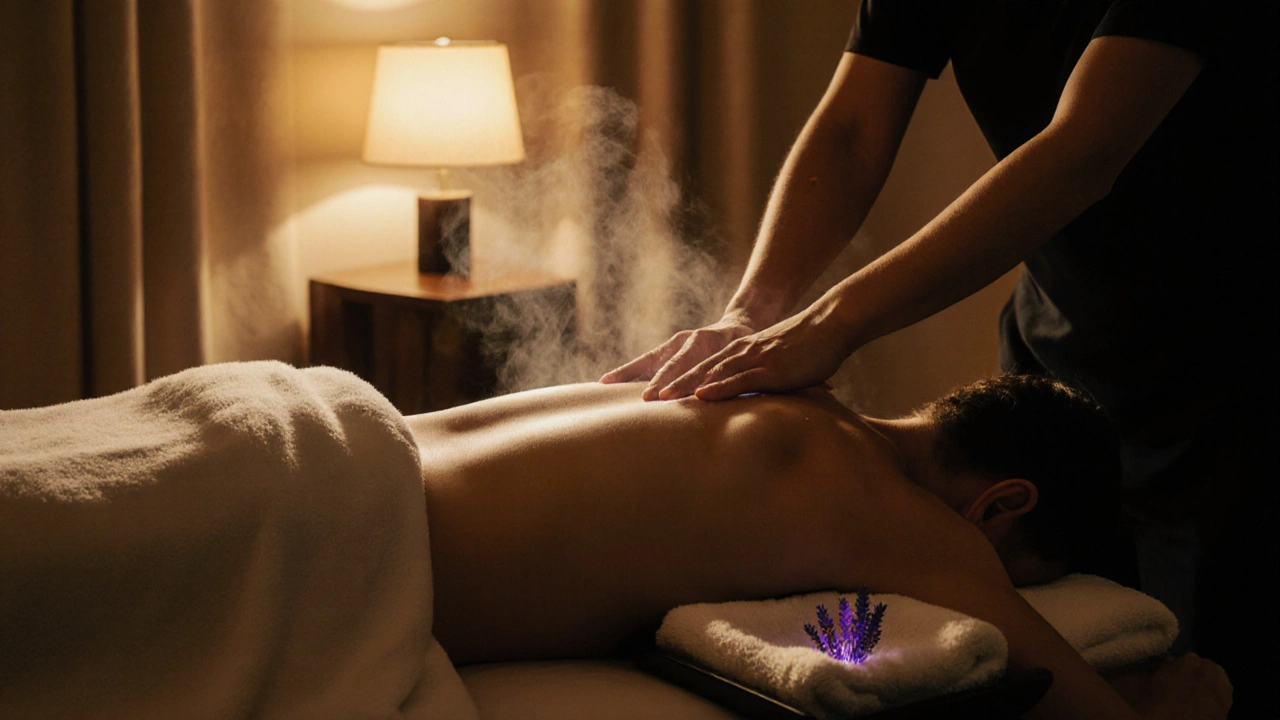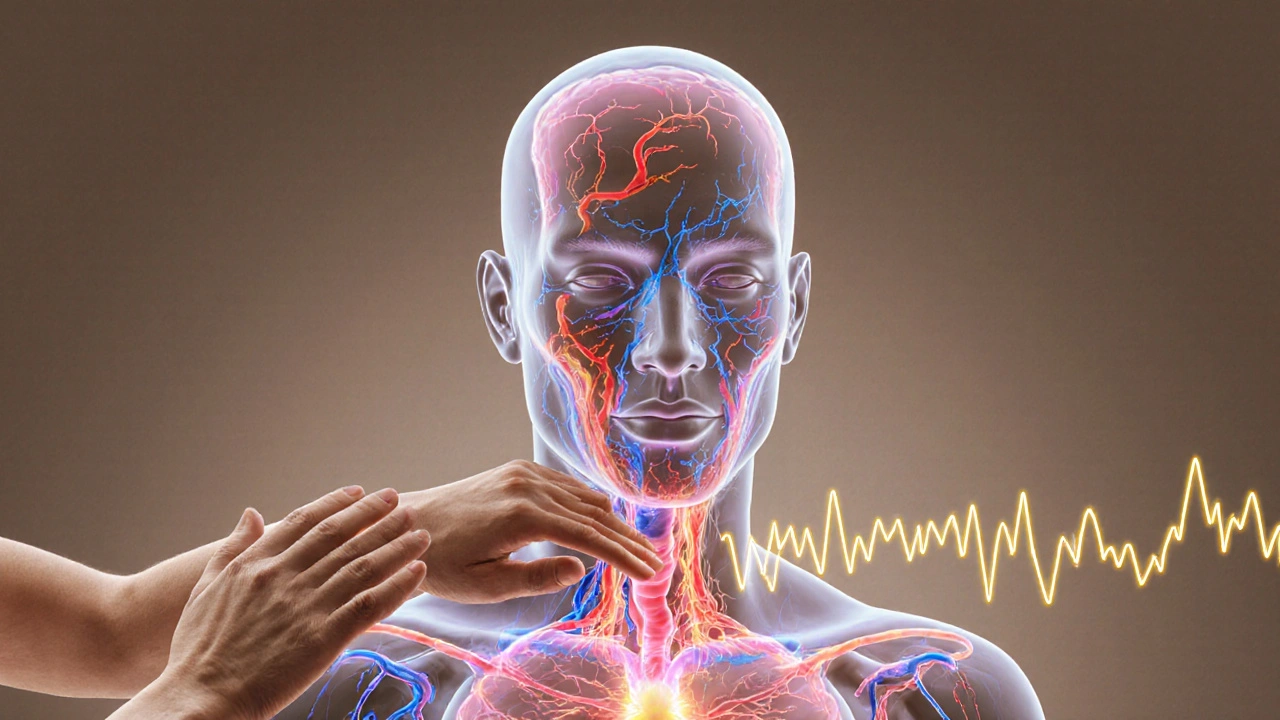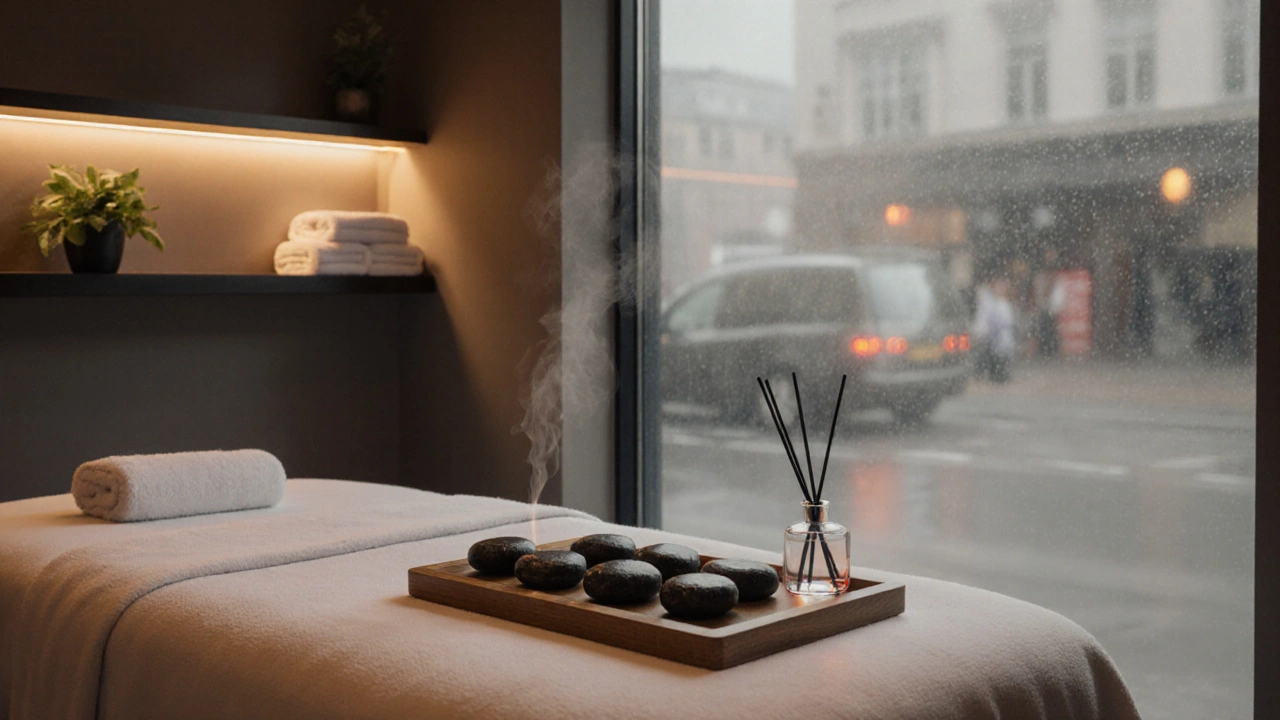Discover how finding a 'massage near me' can melt away your stress and bring real relaxation into your life. This article breaks down everything you need to know about therapeutic massages, how to pick the best place near you, what actually happens during a session, and how much you can expect to pay. You'll get the inside scoop on the different types of massages you can try, plus crucial tips to make sure your session is safe and comfortable. From practical benefits to navigating your local options, this guide will help you find a better way to unwind. Start your journey to less stress and a happier, healthier you.

- Created by: Elara Wainwright
- Completed on: 31 Oct 2025
- Categories: Swedish Massage
You’ve probably heard of Swedish massage. Maybe you’ve had one after a long week, or maybe you’re just curious why it’s the most popular type of massage in the world. But have you ever stopped to wonder how it actually works? Not just the feeling-the real, biological, scientific stuff beneath the lavender oil and warm towels?
It’s not magic. It’s physiology. And understanding it changes everything.
What Swedish Massage Really Is (And What It’s Not)
Swedish massage isn’t just gentle rubbing. It’s a system. Developed in the 18th century by Swedish physiologist Per Henrik Ling, it’s built on five core techniques: effleurage (gliding strokes), petrissage (kneading), friction (deep circular pressure), tapotement (rhythmic tapping), and vibration. These aren’t random motions-they’re carefully ordered to trigger specific responses in your body.
Think of it like a reset button for your nervous system. While deep tissue massage digs into knots, Swedish massage talks to your skin, muscles, and nerves in a language they understand: slow, rhythmic, predictable pressure. That’s why it’s the go-to for stress relief, not injury rehab.
How Your Body Reacts-Step by Step
Within seconds of the first stroke, your body starts shifting. Your skin detects the warmth and pressure. Sensors called mechanoreceptors send signals to your brain: “This is safe. This is calm.” That shuts down your fight-or-flight mode.
Within minutes, your cortisol levels drop. A 2010 study from the University of Miami found that just one 60-minute Swedish massage reduced cortisol by an average of 31%. Cortisol is your body’s main stress hormone. High levels mean tension, poor sleep, and a weakened immune system. Lowering it? That’s not just relaxation-it’s biological repair.
At the same time, your brain releases serotonin and dopamine. These are your natural mood boosters. That post-massage glow? It’s not just the scent of eucalyptus. It’s your brain saying, “We’re okay now.”
Then comes the circulation boost. Effleurage strokes act like gentle pumps, pushing blood through veins and lymphatic vessels. This flushes out metabolic waste-lactic acid, inflammatory cytokines, leftover toxins-from tired muscles. You don’t need to “detox” with juice cleanses. A good Swedish massage does it naturally.
Why It Works Better Than You Think
Here’s the part most people miss: Swedish massage doesn’t just relax your muscles. It rewires your nervous system.
Chronic stress keeps your sympathetic nervous system (the “go” system) stuck on high. Swedish massage flips the switch to your parasympathetic system-the “rest and digest” mode. Your heart rate slows. Your breathing deepens. Your digestion kicks in. Your body starts healing instead of surviving.
Studies from the Journal of Clinical Psychiatry show that regular Swedish massage improves sleep quality in people with insomnia. Another in Complementary Therapies in Clinical Practice found it reduced anxiety in cancer patients more effectively than quiet rest alone.
And it’s not just mental. The mechanical pressure increases blood flow to tissues by up to 30%, according to research from the University of Illinois. That means more oxygen, more nutrients, and faster recovery-even if you’re not an athlete.
Swedish vs. Other Massage Types
| Technique | Pressure | Primary Goal | Best For |
|---|---|---|---|
| Swedish Massage | Light to medium | Relaxation, circulation, stress relief | First-timers, stress, poor sleep, anxiety |
| Deep Tissue | Heavy, focused | Break down scar tissue, treat chronic pain | Athletes, injury recovery, persistent muscle tightness |
| Hot Stone | Medium, with heat | Deep muscle relaxation, circulation | Cold sensitivity, stiff neck, arthritis |
| Thai Massage | Active, stretching-based | Flexibility, energy flow | People who like yoga, tight hips, poor mobility |
| Aromatherapy Massage | Light to medium | Emotional balance, mood enhancement | Anxiety, low mood, sensory overload |
Swedish massage is the baseline. It’s the gateway. You don’t need to be in pain to benefit. You just need to be human.

What Happens During a Typical Session
You’ll lie on a padded table, covered with a sheet. The therapist will leave you privacy to undress and get comfortable. They’ll use oil or lotion-not too slippery, not too sticky. The room will be warm. Soft music plays. The lights are dim.
The session starts with long, flowing strokes along your back, legs, arms. It’s not random. They’re warming the tissue, preparing it for deeper work. Then comes kneading-gentle but firm-on your shoulders, glutes, calves. You might feel a little ache, but never sharp pain. If you do, speak up. Good therapists adjust on the spot.
Tapotement might surprise you. Light, quick taps on your back or feet. It doesn’t feel like a drum solo. It feels like your muscles waking up. The whole session lasts 60 to 90 minutes. No one rushes. No one checks the clock. You’re meant to drift.
How Often Should You Get One?
If you’re stressed, overwhelmed, or just tired of feeling like you’re running on fumes, once a month is a sweet spot. It’s enough to keep your nervous system balanced without breaking the bank.
For people with chronic stress, insomnia, or high-pressure jobs, every two weeks works better. A 2021 study from the International Journal of Therapeutic Massage & Bodywork showed that participants who received biweekly Swedish massages reported 40% less perceived stress over 12 weeks.
And you don’t need a spa. Many licensed therapists offer home visits in London-especially in areas like Notting Hill, Shoreditch, and Hampstead. It’s easier than you think.
Who Should Avoid It?
Swedish massage is safe for almost everyone. But skip it if you have:
- An active infection or fever
- Recent surgery or open wounds
- Severe osteoporosis (without clearance from your doctor)
- Deep vein thrombosis (blood clots)
- Uncontrolled high blood pressure
If you’re pregnant, it’s fine-but only after the first trimester and only with a therapist trained in prenatal massage. Always tell your therapist about any health conditions. That’s not just advice-it’s a safety rule.

How to Find a Good Therapist in London
Look for someone certified by the Complementary and Natural Healthcare Council (CNHC). That’s the UK’s official register for qualified therapists. You can check their credentials online.
Read reviews-not just star ratings. Look for comments like “felt heard,” “adjusted pressure,” or “didn’t rush.” Avoid places that sound like spas selling “luxury detox packages.” Real therapists focus on your body, not your wallet.
Ask if they’ve trained in anatomy and physiology. A good therapist knows where your sciatic nerve runs. They know how to avoid putting pressure on your carotid artery. That’s not guesswork. That’s education.
What to Do After Your Session
Drink water. Seriously. You just flushed toxins out of your muscles. Your body needs help getting rid of them.
Don’t jump into a workout or a cold shower. Give yourself a few hours to let the calm settle. Maybe take a nap. Walk slowly. Listen to quiet music.
Some people feel a little sore the next day. That’s normal-it’s your muscles adjusting. But if you feel bruised, dizzy, or in pain, call your therapist. That’s not supposed to happen.
Frequently Asked Questions
Is Swedish massage just for relaxation?
No. While it’s best known for relaxation, the physiological effects go deeper. It lowers stress hormones, improves circulation, reduces muscle stiffness, and even boosts immune function. Many people with chronic headaches, insomnia, or mild anxiety find lasting relief-not because it’s “nice,” but because it changes how their body functions.
Does Swedish massage help with back pain?
Yes, especially if the pain is caused by tension, not injury. A 2017 study in the Annals of Internal Medicine found that participants with chronic lower back pain who received weekly Swedish massages for 10 weeks reported significantly less pain and better mobility than those who didn’t. It doesn’t fix herniated discs-but it can ease the muscle guarding that makes pain worse.
Can I get Swedish massage if I’m not stressed?
Absolutely. You don’t need to be in crisis to benefit. Many people use it as preventive care-like brushing your teeth. Regular sessions help maintain balance in your nervous system, improve sleep quality, and keep your muscles flexible. Think of it as maintenance for your body’s stress response.
Why do I feel tired after a Swedish massage?
Your body just shifted from survival mode to repair mode. That’s exhausting. Your nervous system was on high alert for days, weeks, or months. Now it’s finally allowed to relax. The fatigue is a sign it’s working. Rest for a few hours, hydrate, and you’ll wake up feeling lighter.
Is Swedish massage worth the cost?
If you’re paying £60-£80 for a 60-minute session, it’s comparable to a good gym membership or a weekly coffee habit. But unlike coffee, it reduces stress, improves sleep, and lowers inflammation. When you factor in fewer sick days, better focus at work, and less reliance on painkillers, it’s one of the most cost-effective health investments you can make.
Final Thought: It’s Not Just a Treat. It’s Medicine.
Swedish massage isn’t a luxury. It’s a tool. A simple, safe, science-backed way to reset your body’s stress response. You don’t need to believe in energy channels or chakras to benefit. You just need to know that your body responds to touch-and that touch, done right, can heal.
So next time you think about skipping your massage because you’re “too busy,” remember this: You’re not wasting time. You’re investing in your nervous system. And that’s the most important thing you can do for your health today.
Couples massage isn’t just about getting pampered—it’s a real way to connect and relax together. This article breaks down what to expect, why couples love these sessions, and how to find the best local options. We’ve got tips on booking, safety, and even whether it’s worth it compared to going solo. If you’ve ever wondered how a massage gets you both on the same page, you’re in the right place. Let’s dig into the real feel and benefits of couples massage.
Discover what a hot stone massage in London feels like, from stone placement and benefits to pricing, safety tips, and how to book your session.




Stuart Ashenbrenner
November 1, 2025 AT 07:58Look, I don't care what some 18th-century Swede invented. I got a massage last week and my back felt like it had been unplugged from the wall. No magic, no chakras, just pressure and time. My therapist didn't even use lavender-just coconut oil and zero bullshit. I slept for 9 hours straight. That's the science right there. Your body knows when it's being cared for. Stop overthinking it and book the damn appointment.
Raven Ridinger
November 1, 2025 AT 22:31Oh, please. 'Swedish massage'? As if Sweden invented relaxation? What about the ancient Greeks? The Egyptians? The Chinese? And why is it always 'Swedish'-like the only culture that ever touched a human body was a bunch of bearded men in Luleå? Also-'effleurage'? That’s not a word, it’s a typo. And you used 'they're' incorrectly THREE times in this post. Honestly, if you’re going to cite studies, at least proofread. Also-why is everyone so obsessed with cortisol? It’s not a demon. It’s a hormone. You’re treating your body like a broken toaster that needs a reset button. Ugh.
Timothy Chifamba
November 2, 2025 AT 03:06Man, I’ve been doing massage therapy in Lagos for over 12 years, and I can tell you-this is spot on. The trick isn’t the oil or the music-it’s rhythm. Your body remembers pressure patterns. If you move slow and steady, your muscles think, 'Oh, we’re safe now.' No need for fancy terms. I use palm pressure, fingers, even elbows. And yeah-drink water after. I tell every client: 'Don’t run, don’t drink alcohol, don’t check your phone for an hour.' Just breathe. One lady came back saying her insomnia was gone after three sessions. No pills. Just touch. Simple. Real. You don’t need a spa in Notting Hill to feel this. Just someone who knows what they’re doing.
andre maimora
November 2, 2025 AT 14:28Swedish massage? More like corporate wellness propaganda. The real science? Cortisol drops because your brain thinks you’re being cuddled by a government-approved relaxation drone. They pump you full of lavender because it masks the smell of cheap massage oil. And don’t get me started on 'CNHC certification'-that’s just a front for Big Massage to keep out independent practitioners. I got my training from a guy in Albuquerque who learned from his grandma. No license. No oil. Just hands. And guess what? My back’s better than yours. They’re controlling your relaxation. Wake up.
Delilah Friedler
November 2, 2025 AT 18:16This is one of the most well-researched and clearly articulated pieces on massage therapy I’ve read in years. The breakdown of physiological responses-especially the distinction between sympathetic and parasympathetic activation-is both accurate and accessible. I appreciate the inclusion of peer-reviewed studies and the practical guidance on finding qualified therapists. It’s refreshing to see a topic often dismissed as 'woo' treated with such rigor. Thank you for taking the time to compile this. I’ve shared it with my colleagues in physical therapy and will be recommending it to patients who are skeptical about complementary approaches.
Sloan Leggett
November 2, 2025 AT 20:53You say Swedish massage is 'medicine.' But you didn't cite a single FDA-approved clinical trial. You cited journals-some of which are predatory. You mentioned 'metabolic waste'-but that's not a medical term. Lactic acid doesn't cause soreness. And you imply massage 'flushes toxins'-a term banned by every legitimate medical association since 2015. This isn't science. It's pseudoscience dressed in APA formatting. If you want to relax, meditate. If you want to heal, see a doctor. Stop pretending touch is a cure-all. It's not. And you're misleading people.